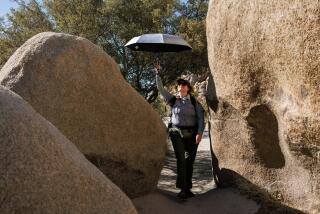A Tree Goes to Brooklyn
A refrigerated 18-wheel truck set off Monday from the Antelope Valley for Brooklyn, N.Y., carrying precious cargo: a 10-foot-tall, 2,000-pound Joshua tree.
The horticultural odyssey combines the efforts of a retired Palmdale forester turned crusading protector of Joshua trees, a Malibu landscaper and officials at the Brooklyn Botanic Garden, a 50-acre oasis of greenery in a tough urban landscape.
Edmond Moulin, director of horticulture at the garden, had been pining for a Joshua tree to complete a new exhibit of desert vegetation from around the world. But he thought the trees had protected status in California and were hard to get.
In fact, Joshua trees are protected on some state land but not on private property, as Malibu landscaper Betty Jo McDonald told Moulin when she visited the New York exhibit earlier this year.
“I told him they chop them down and take them to the dump every day,” McDonald said. “I told him I could get him a Joshua tree.”
The Desert Pavilion is one of three enclosed, climate-controlled exhibits that are centerpieces of the Botanic Garden. The other two are the Tropical Pavilion, devoted to tropical plants, and the Temperate Pavilion, displaying flora from the Mediterranean and Near East.
Moulin said the newly refurbished Desert Pavilion contains a range of plants, sand and stone representing desert environments of different continents. The Joshua tree will be a dominant feature of the “New World” section of the desert display, he said.
The sturdy trees, which look like gnarled, spiny claws on squat trunks, grow in the Mojave Desert and require minimal water. They have become the object of a crusade for nature lovers in the Antelope Valley because thousands have been chopped down to make way for a wave of development in recent years.
Environmentalists such as Tony Baal of Palmdale, who supplied the tree for the Brooklyn Botanic Garden, see Joshua trees as a symbol of high desert heritage threatened by the building boom.
Baal uses a mechanical tree spade to uproot Joshua trees, which he sells and transplants. He said he has sent Joshua trees to other states, but never as far as New York.
“What a production,” Baal said Monday at his Christmas tree farm as a large crane slowly hoisted the boxed tree into a produce truck, where it will ride at a controlled temperature of 70 degrees.
Baal and McDonald also threw in a smaller Joshua tree and five cholla cacti, desert plants missing from the Brooklyn display. The trees were obtained from county-owned land near the site of the Palmdale Regional Airport, where Baal has a contract to remove them.
Baal, a retired county forester, worked as a city consultant on Joshua trees for several years. He quit in frustration with what he called government officials’ lack of energy in protecting them and started his own consulting business.
“I can’t believe what they’re doing to the desert environment,” Baal said. He hopes the interest expressed by faraway plant specialists will spur new local interest in preserving desert vegetation.
Carlton Collier, the Dallas trucker entrusted with transporting the desert specimens, made sure the plants were secure in a small part of a cavernous cargo area that usually carries avocados or other produce.
Paying Good Money
“They’re sure paying good money for a light load,” he drawled.
The Botanic Garden, which is run jointly by the city of New York and a private nonprofit corporation, will pay almost $6,000 for packing and shipping of the tree. The expense is well worth it, Moulin said.
“This is a tree that should be protected,” he said. “It was something we wanted and we are happy to have. It will be transplanted. This is not a temporary educational display.”
Baal said he has full confidence that the tree will thrive in its new home. And he plans to make sure.
“I’ve going to Pennsylvania next year for a high school reunion,” he said. “And then I’m going to go check on my tree.”






